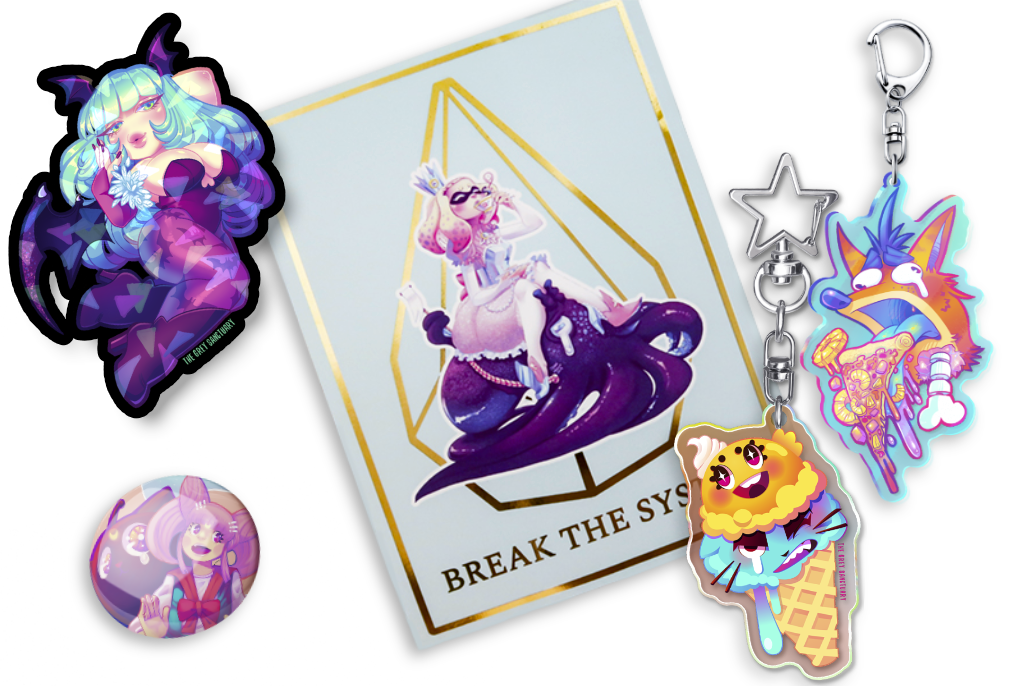

Little Cathedral Blog
Let’s Talk About Art Licensing & Royalties – Part 2
We previously discussed the basics of art licensing and royalties, now we will dig deeper with technical and complex details that are essential to establish before finalizing the negotiation. This will include elements that should be discussed beforehand, how to calculate royalties, the importance of registering your work, and more.
Metrics of Compensation
Royalties rates can vary depending on the circumstances and agreements. These can be one-time payments to recurring payments depending on the time frame, usage, and other terms or clauses in the contract. Others can also be an upfront payment, with the possibility of the artist not becoming dependent on future income if the sales of their work become successful or not. The percentage earned in royalties depends on the type of license granted (ex. selling illustrated books vs. selling pattern designs in different merchandise by a store).
- Flat fee: Fixed price.
- Percentages: A gross or net revenues derived from the use or sale of a work.
- Non-Refundable Advance Royalties: This is an up-front payment made to an artist before their work is produced and sold.
- One-time License Fee – This is a one-time payment (not deducted from royalties) that is agreed upon when there is an anticipation that the licensed product will not successfully sell.
- Advance Against royalties: It is usually a non-refundable payment made at the start of a licensing period or the contract is signed, and is deducted from future royalty payments. This is based on the licensee’s estimate of how much the project or artwork will earn during sales (regardless if it becomes unsuccessful, the artist doesn’t have to return the payment unless the contract has been breached). However, the artist will not earn any additional revenue from their work until it achieves more than the advance payment. This is well known as a “guaranteed minimum royalty payment” and is ideal as a safeguard against losing out on royalties.
What Should Be Discussed?
- Type of media.
- Types of rights granted.
- Medium of intended use.
- Title of the work or product.
- Mass market vs. special market.
- The volume of sales or appearances.
- Shipping and handling responsibilities.
- Type of industry (video game, illustration book, animation, etc.)
- State any specific discount (a max. If any) to the customer.
- Editions (if any).
- The parties involved.
- Distribution channel.
- Analytics and sale data.
- End of use terms (clause).
- Degree of exclusivity (if any).
- The time frame or expiration.
- Period constraint or unlimited use.
- The amount of royalties, advance payment, etc.
- Business or geographic location(s)
Reiterate the impact of the work, which will last much longer than the length of the project. Even a greeting card is so much more than a $4 transaction, it’s an experience from one person to another.
Graphic Artist Guild Handbook Pricing & Ethical Guidelines 14 Edition
How To Calculate Royalties
You can do research with your colleagues who are currently working with licenses, local businesses, or virtual platforms as a guidance on how much profit they make (ex. RedBubble, InPrint, Threadless, etc.) compared to the artist earnings. Of course, you can’t compare yourself, an independent creator, with a company due to unrealistic factors, yet it doesn’t mean you should be compensated less. Investing in an agent is recommendable not just for successful deals, but also for protecting you and guiding you with the best interest.
- Royalties Payments – The royalty percentage is multiplied by the net sales. For example, if $1,000 in net sales is multiplied by a 5% royalty rate, the resulting royalty is $50.
- Per-Unit Royalty – This doesn’t relate to the overall amount of money made from sales, but rather to the quantity of units sold or manufactured.
However, You Should Keep In Mind That…
Royalty rates will be affected according to the industries and market value. There is a possibility that when products are sold in mass markets, an artist may earn more money from a lower royalty rate than they would from a higher royalty rate for products sold in small stores. For retailers, their royalty rate may vary (ex. 2% and up) whereas wholesales may provide larger rates (ex. 15% and up) from the price of the product’s sale.
- The higher the volume, the lower the royalty – Mass market merchants (ex. Walmart) will provide affordable pricing to their target audience, which means it will result in tighter profit margins from the manufacturer, thus lowering the royalty rate if the items are sold in large quantities and at mass market shops.
- The lower the volume, the higher the royalty – The royalty rate should be higher if the items are sold in specialized stores and fewer quantities.
But again, it will depend on the factors, a fair negotiation, and your connections that may elevate your income and performance.
How Can I Begin Doing Art Licensing?
- Research what’s in demand in the market and create works according to the specific niches or industries you would like to be part of.
- You can create a specific category (for licensing) in your portfolio and diversify your works with the themes and styles you like or feel comfortable.
- Investigate trends, learn to market yourself, and study the target audience for better chances to increase your exposure.
- Start investing in professional people who can help you expand and elevate your work, including expanding your network and asking for referrals, reliable connections, or resources.
Distribution Of Right
By default, the artwork’s creator remains the copyright holder of the distribution control. Once that right gets sold to a specific individual, the artwork can be resold, passed on, rented, and so forth, but it can’t be used for derivative works or copied entirely.
So, What Are The Pros With Art Licensing?
Even though it may seem complicated the process of negotiating with licensing your works and obtaining fair royalty rates, it is still a rewarding experience to learn how much you can capitalize on your creativity with a passive income, strong network, and resources.
- Explore new markets and venues.
- Generate new and regular passive income.
- Reach new and broader audiences in a time frame.
- Obtain more protection of the integrity of every single work.
That’s it for now with the first part. You can read the first part about Art Licensing & Royalties for the basic elements and understand each term. Also, if you are interested, I wrote The Importance Of Creating A Contract Part 1 and Part 2, how to build contracts for Work For Hire, Commission, Art Licensing & Royalties and Estimate, Invoice, and Receipt.
NOTE: I want to emphasize that this post is for educational purposes, legal information is not the same as legal advice. Therefore, it is recommended that you consult with a lawyer to obtain more professional guidance in the legal field.
Resources
Graphic Artist’s Guild. (2013). Graphic artist’s guild handbook of pricing and ethical guidelines (14th ed.). Graphic Artists Guild.
Brophy, M. (2012, April 26). What to charge for art licensing – royalties advances and flat fees. Maria Brophy. https://mariabrophy.com/art-licensing/what-to-charge-for-art-licensing-royalties-advances-and-flat-fees.html
QueryLetter.com. (2020, November 10). How do advances and royalties work?. QueryLetter.com. https://www.queryletter.com/post/how-do-advances-and-royalties-work
Stim, R., & Farkas, B. (2023, May 18). Licensing artwork: Negotiating and Monitoring Royalty payments. www.nolo.com. https://www.nolo.com/legal-encyclopedia/licensing-artwork-negotiating-monitoring-royalty-payments-30093.html
Cook, B. (2024, November 15). Royalty payments: A comprehensive guide. Tipalti. https://tipalti.com/blog/royalty-payments/
Salunkhe, R. (2024, November 27). A guide to art royalties and licensing for creative success. Photo To Portrait: Hand-Painted Portraits By Pro Artists. https://www.whataportrait.com/blog/art-royalties-and-licensing-guide/
Thank You For Reading!
If you like my work and documentation and wish to see more, please consider contributing to my growth and hard work with more exploration, investment, and website maintenance.











Leave a Reply